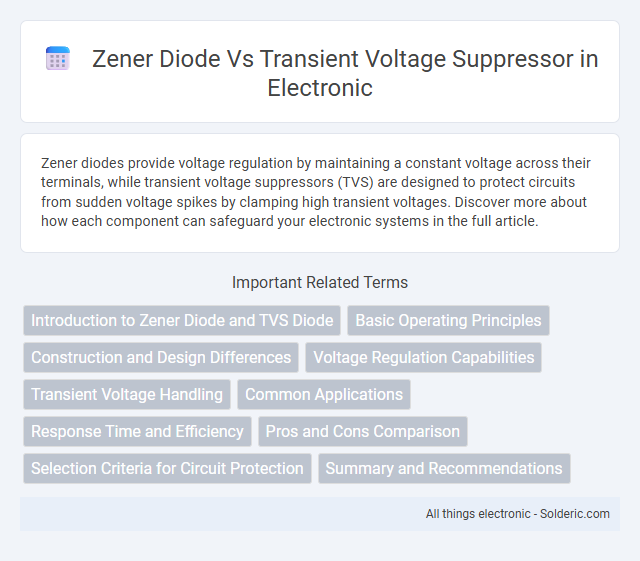Zener diodes provide voltage regulation by maintaining a constant voltage across their terminals, while transient voltage suppressors (TVS) are designed to protect circuits from sudden voltage spikes by clamping high transient voltages. Discover more about how each component can safeguard your electronic systems in the full article.
Comparison Table
| Feature | Zener Diode | Transient Voltage Suppressor (TVS) |
|---|---|---|
| Primary Function | Voltage regulation and reference | Transient voltage spike protection |
| Operation Voltage | Fixed breakdown voltage (Zener voltage) | Clamping voltage varies with transient events |
| Response Time | Slower, millisecond range | Fast, picosecond to nanosecond range |
| Energy Absorption Capacity | Low energy handling | High energy handling, designed for surges |
| Typical Applications | Voltage reference, voltage stabilization | Protect sensitive electronics from ESD, lightning, and switching spikes |
| Construction | Semiconductor PN junction diode | Specialized semiconductor device, often avalanche diode-based |
| Cost | Generally lower cost | Higher cost due to ruggedness and fast response |
Introduction to Zener Diode and TVS Diode
Zener diodes are semiconductor devices designed to regulate voltage by allowing current to flow in the reverse direction when a specific breakdown voltage is reached, providing stable voltage reference in electronic circuits. Transient voltage suppressors (TVS) diodes protect sensitive electronic components from voltage spikes by clamping transient voltages and dissipating surge energy rapidly. Both Zener and TVS diodes are critical for voltage regulation and protection, yet Zener diodes maintain steady voltage levels while TVS diodes primarily guard against transient voltage events.
Basic Operating Principles
Zener diodes regulate voltage by maintaining a stable reference at a specific breakdown voltage, allowing current to flow in reverse once that threshold is reached. Transient Voltage Suppressors (TVS) protect circuits by clamping sudden voltage spikes through rapid switching to a low-resistance state, effectively diverting transient energy away from sensitive components. Your choice between these devices depends on whether controlled voltage regulation or transient overvoltage protection is needed.
Construction and Design Differences
Zener diodes are constructed with a precisely doped p-n junction that allows them to maintain a stable breakdown voltage for voltage regulation applications. Transient voltage suppressors (TVS) consist of multiple semiconductor junctions or layers designed to rapidly clamp high-energy voltage spikes and protect sensitive electronic components. The TVS's rugged, multilayered design enables it to absorb transient surges more effectively compared to the simpler, single-junction structure of Zener diodes.
Voltage Regulation Capabilities
Zener diodes maintain a precise reference voltage by operating in the reverse breakdown region, making them ideal for voltage regulation in low-power applications with steady-state conditions. Transient voltage suppressors (TVS) are designed to protect circuits from sudden voltage spikes by clamping high transient voltages quickly, but they are not optimized for continuous voltage regulation. The voltage regulation capability of Zener diodes excels in maintaining stable voltages, whereas TVS devices prioritize transient spike suppression without providing consistent voltage control.
Transient Voltage Handling
Zener diodes are designed for voltage regulation with limited transient voltage handling capability, primarily clamping voltage at a specific breakdown level. Transient Voltage Suppressors (TVS) provide superior transient voltage handling by rapidly shunting high-energy transient spikes, often handling thousands of watts in short bursts. TVS devices are specifically engineered to protect sensitive electronic circuits from voltage spikes caused by lightning or electrostatic discharge.
Common Applications
Zener diodes are commonly used for voltage regulation and reference in power supplies, protecting sensitive circuits by clamping voltage to a specified level. Transient voltage suppressors (TVS) are primarily employed for protecting electronic components from high-voltage spikes and electrostatic discharge (ESD) in communication lines, automotive electronics, and consumer devices. Both devices ensure circuit reliability but differ in response speed and energy absorption capabilities tailored to their specific applications.
Response Time and Efficiency
Zener diodes have a slower response time compared to transient voltage suppressors (TVS), making TVS devices more efficient for protecting circuits against sudden voltage spikes. TVS diodes can react within picoseconds, effectively clamping transient voltages and preventing damage, whereas Zener diodes typically respond in nanoseconds due to their breakdown voltage characteristics. Your choice between these components should consider the speed and efficiency required for real-time circuit protection.
Pros and Cons Comparison
Zener diodes offer precise voltage regulation at a specific breakdown voltage, making them ideal for low-voltage applications with stable current requirements. Transient voltage suppressors (TVS) provide superior protection against high-energy voltage spikes and fast transient surges, enhancing circuit reliability during unexpected surges. Your choice depends on whether you prioritize regulated voltage or robust transient protection in your design.
Selection Criteria for Circuit Protection
Selecting between a Zener diode and a transient voltage suppressor (TVS) for circuit protection depends on your specific voltage clamping needs and response time requirements. Zener diodes are ideal for voltage regulation and protection against steady-state overvoltage conditions within precise voltage thresholds, while TVS diodes excel at rapidly clamping transient voltage spikes caused by electrostatic discharge (ESD) or lightning. Consider your circuit's transient energy levels, maximum clamping voltage, response speed, and power dissipation capacity to ensure effective and reliable protection.
Summary and Recommendations
Zener diodes provide precise voltage regulation by clamping voltage at a defined breakdown level, making them ideal for low-power, steady-state voltage control applications. Transient voltage suppressors (TVS) rapidly absorb high-energy spikes to protect sensitive electronics from transient voltage surges and spikes, excelling in high-power surge environments. For your circuit protection, choose Zener diodes when stable voltage reference is needed, and TVS devices for robust transient surge suppression.
Zener diode vs transient voltage suppressor Infographic

 solderic.com
solderic.com